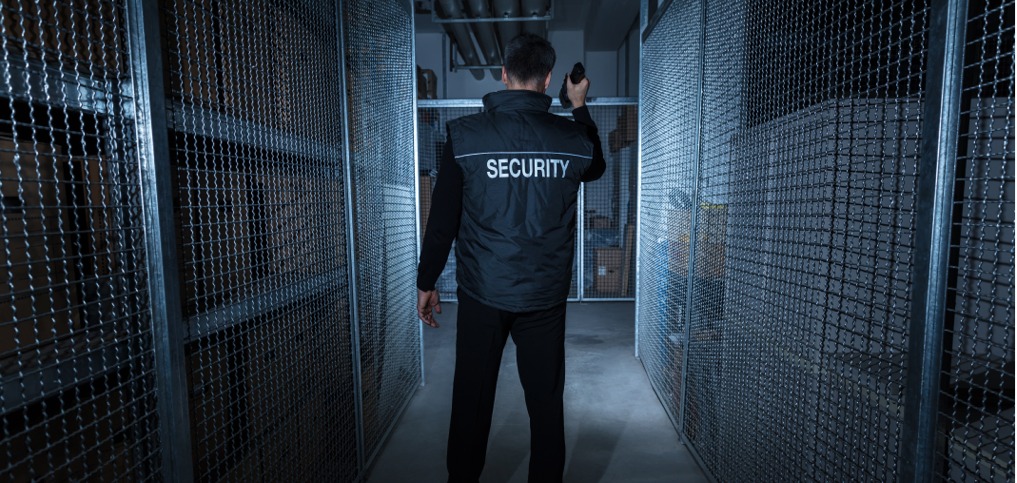Comprehensive Warehouse Security Checklist for Preventing Theft and Vandalism
Introduction
Given the significant risks posed by theft and vandalism, warehouse security is a top priority in the UK. Recent statistics show warehouse theft has been increasing, costing businesses millions yearly. Vandalism, while less financially devastating, can disrupt operations and damage reputations.
This blog post aims to provide a detailed, actionable checklist for warehouse managers, business owners, security personnel, logistics managers, and facility managers to enhance security measures. Let’s dive into a comprehensive checklist to secure your warehouse against potential threats.
Understanding Warehouse Security Risks
Understanding the various security risks that threaten warehouses is crucial to effectively securing them. Warehouses face many challenges, and comprehending these risks is the first step in developing a robust security plan.

- Opportunistic Theft happens when intruders exploit vulnerabilities, such as unlocked doors or unguarded areas, to steal goods. Due to the high-value items stored within, opportunistic thieves often target warehouses.
- Organised Crime: More sophisticated than opportunistic Theft, organised crime involves well-planned and coordinated efforts to breach warehouse security. Criminal gangs often have insider knowledge and use advanced methods to bypass security systems.
- Internal Threats: Employees or contractors with malicious intent can exploit their access privileges to steal or damage goods. Internal threats are often more complex and require stringent access control measures. Temporary staffing can also pose significant risks, as these individuals are often onsite for short periods and may not hold any loyalty to the company.
- Property Damage: Vandalism includes acts such as graffiti, breaking windows, and damaging doors, which can lead to costly repairs and operational downtime.
- Disruption of Operations: Beyond physical damage, vandalism can disrupt warehouse operations, leading to shipment delays and a tarnished reputation among clients and partners.
Trespassers: Individuals who enter the warehouse premises without permission pose a significant risk. Trespassers might not always be motivated by Theft; some might be seeking shelter or committing acts of vandalism.
Specific Challenges in the UK
Warehouses in the UK face unique challenges that necessitate tailored security measures.
Urban and Rural Differences
Urban warehouses are often targets for organised crime due to their proximity to transport hubs and dense population areas, making it easier for criminals to blend in. In contrast, rural warehouses might face less frequent but more severe attacks due to their isolation and lack of immediate law enforcement presence.Legislation and Compliance
The UK has stringent regulations regarding health and safety, data protection, and security measures. Warehouses must comply with laws such as the General Data Protection Regulation (GDPR) and the Health and Safety at Work Act, influencing how security systems are implemented and managed.
Weather Conditions
Adverse weather can impact security infrastructure, damaging fencing, affecting the visibility of surveillance cameras, or causing power outages that turn off security systems.
Physical Security Measures
Perimeter Security
Securing the perimeter is your first line of defense. Here’s what you need to consider:
- Fencing and Barriers: Strong, high fences and barriers deter unauthorised entry.
- Gates and Entry Points: Secure gates with controlled access to monitor who enters and out.
- Lighting and Visibility: Well-lit areas reduce hiding spots for intruders and enhance CCTV footage quality.
Using AI Cameras for Warehouse Security
Implementing AI cameras with face and object detection enhances warehouse security. Here’s a quick guide:
Choose AI Cameras
- Features: High-resolution, low-light, AI face, and object detection.
Strategic Placement
- Entry/Exit: Monitor all entrances and exits.
- High-Traffic: Place in busy areas like loading docks.
- Sensitive Zones: Cover critical areas.
System Setup
- Network: Use Power over Ethernet (PoE) for stability.
- Power: Ensure reliable power via PoE.
Configure AI
- Face Detection: Log and recognize faces.
- Object Detection: Monitor and identify objects.
Integrate Software
- Software: Use AI-compatible software like Milestone.
- Alerts: Set up real-time alerts.
- Storage: Secure on-site or cloud storage.
Set Notifications
- Custom Alerts: Configure for specific events.
- Mobile Integration: Real-time alerts on mobile devices.
Maintenance
- Updates: Regularly update firmware.
- Checks: Routine system checks.
Train Staff
- Training: Teach the use of AI features and alert responses.
- Drills: Conduct regular security drills.
Building Security
Inside the perimeter, focus on the building itself:
- Reinforced Doors and Windows: Invest in sturdy doors and windows resistant to forced entry.
- Secure Loading Bays: Loading areas are vulnerable; ensure they’re monitored and secure.
- Alarm Systems and Sensors: Install alarms and sensors to detect unauthorised access immediately.
Access Control Systems
Controlling who can access your warehouse is critical. Here are key points to implement practical Warehouse Access Control Systems:
- Keycards and Biometric Systems: Use advanced access systems to restrict entry to authorised personnel only.
- PIN Codes: An additional layer of security for high-risk areas.
- Visitor Logs: Keep detailed records of all visitors to track who enters and exits the facility.
Surveillance and Monitoring
Warehouse Surveillance and Monitoring are vital for both deterrence and evidence gathering. Effective surveillance systems provide a continuous watch over the premises, deterring potential intruders and providing crucial evidence in case of an incident.

CCTV Camera Placement
- Strategic Placement: Place cameras in critical areas such as entrances, exits, loading bays, storage areas, and blind spots. Clear coverage should be provided for high-traffic areas and vulnerable points to capture suspicious activities.
- High-Quality Cameras: Invest in high-definition cameras with night vision capabilities to ensure clear footage in low-light conditions. Consider cameras with wide-angle lenses to cover larger areas.
Remote Monitoring Solutions
- 24/7 Monitoring: Enable off-site monitoring to monitor the warehouse around the clock. This ensures that any suspicious activity is detected and addressed promptly, even when the premises are unoccupied.
- Integration with Mobile Devices: Modern surveillance systems can be integrated with mobile devices, allowing security personnel and managers to monitor live feeds and receive alerts on their smartphones or tablets.
- Cloud Storage: Use cloud storage for video footage to ensure it is securely stored and easily accessible. Cloud storage also protects against data loss in case of physical damage to on-site storage devices.
Integration with Alarm Systems
- Real-Time Alerts: Ensure your CCTV and alarm systems are integrated to provide real-time alerts. When an alarm is triggered, the corresponding camera feed can be automatically brought to attention, allowing immediate assessment and response.
- Automated Responses: Some advanced systems can trigger computerised responses, such as locking doors, turning on additional lighting, or sounding alarms when suspicious activity is detected.
Reviewing and Analyzing Footage
- Regular Reviews: Review surveillance footage to identify patterns or recurring issues. It can help refine security measures and address vulnerabilities.
- Motion Detection and Analytics: Utilise cameras with motion detection and analytics capabilities to highlight unusual activities. These features can filter out false alarms and focus on genuine security threats.
Security Personnel and Training
Having well-trained security personnel is crucial:
- Security Guards: Employ guards to monitor and respond to security incidents.
- Training Programs: Regularly train staff on security protocols and emergency procedures.
- Regular Audits and Drills: Conduct routine security audits and drills to ensure readiness.
Inventory Management and Internal Security
Preventing internal Theft and managing inventory is equally important:
- Strict Inventory Control: Implement robust inventory tracking systems to monitor stock levels.
- Regular Stock Checks: Frequent audits help identify discrepancies early.
- Employee Background Checks: Screen employees to minimise the risk of internal Theft.
Emergency Preparedness
Emergency Preparedness for Warehouses involves planning for the worst:
- Emergency Response Plan: Develop a detailed plan for various emergencies, including Theft, fire, and natural disasters.
- Staff Training: Ensure all employees know the emergency procedures.
- Regular Reviews: Periodically review and update your emergency plans.
Collaborating with Law Enforcement
Building a relationship with local law enforcement can be beneficial:
- Local Law Enforcement: Engage with local police for advice and support.
- Report Suspicious Activities: Encourage reporting of any unusual behavior around the warehouse.
- Community Watch Programs: Participate in or establish community watch programs to enhance security.
Conclusion
In conclusion, securing your warehouse involves a comprehensive approach that covers physical security, access control, surveillance, inventory management, and emergency preparedness. By following this checklist, you can significantly reduce the risks of Theft and vandalism. Regularly review and update your security measures to stay ahead of potential threats.
Warehouse Security Measures Tips and Tricks
Security Measure | Description |
Fencing and Barriers | High-quality fencing to deter unauthorised entry |
Gates and Entry Points | Secure gates with controlled access |
Lighting and Visibility | Adequate lighting to reduce hiding spots and enhance CCTV Tower and MAPS functionality. |
Reinforced Doors and Windows | Strong doors and windows to prevent forced entry |
Secure Loading Bays | Monitored loading areas to prevent unauthorised access |
Alarm Systems and Sensors | Systems to detect unauthorised access immediately |
Keycards and Biometric Systems | Advanced systems to restrict access to authorised personnel |
PIN Codes | Additional layer of security for high-risk areas |
CCTV Camera Placement | Strategic placement to cover critical areas |
Remote Monitoring Solutions | Off-site monitoring for 24/7 surveillance |
Security Guards | Personnel to monitor and respond to incidents |
Training Programs | Regular training for staff on security protocols |
Inventory Control | Robust systems to monitor stock levels |
Emergency Response Plan | Detailed plan for various emergencies |
Local Law Enforcement | Engagement with local police for advice and support |
Implementing these measures can significantly enhance the security of your warehouse and protect against theft and vandalism. Regularly updating and reviewing your security protocols ensures your warehouse remains fortified against evolving threats.
frequently asked questions
The most effective measures include high-quality fencing, secure gates with controlled access, and adequate lighting to deter intruders and enhance visibility.
Access control systems, such as keycards, biometric scanners, and PIN codes, ensure that only authorised personnel can enter, reducing the risk of unauthorised access.
Integration allows for real-time alerts and better coordination between surveillance and response, ensuring quicker action in case of a security breach.
Implement strict inventory controls, conduct regular stock checks, and perform employee background checks to prevent internal Theft.
Building relationships with local police can provide additional support, advice, and quicker responses to security incidents.
